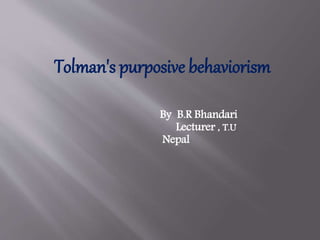
Tolman theory
- 1. Tolman's purposive behaviorism By B.R Bhandari Lecturer , T.U Nepal
- 2. Edward Chace Tolman was an American psychologist. He was born on April 14 1886 and died on November 19 1959. Books: 1. The purposive behavior in animal and man. 2. Drives towards war . 3. Collective pattern in psychology.
- 3. Purposive behaviorism has also been referred to as sign learning theory and is often seen as the link between behaviorism and cognitive theory. Tolman's theory was founded on two psychological views those of the Gestalt theory and those of John Watson, the behavior theory. Tolman's believe that animal were acquiring knowledge about their surroundings he called cognition. Tolman's theory of learning is known by several names such as sign significance theory, expectancy theory, purposive behaviorism or simple sign theory
- 4. Learning is purposive and goal directed. Organisms will select the shortest or easiest path to achieve a goal. Behavior is not mechanical. Behavior as a complete purposeful exercise. Behavior can be modified by experience and training. Reinforcement is not essential for learning. Cognitive interpretation by the individual.
- 5. Goal directedness Cognitive maps Latent learning Intervening variables Reward Expectancy Place Learning Versus Response Learning
- 6. Tolman asserted that learning is always purposive and goal directed .He held the notion that an organism acted or responded for some adoptive purpose. He believes individual do more than merely respond to stimuli they act on beliefs, attitudes, changing conditions, and they strive toward goals.
- 9. This is tendency to 'learn location'. In this famous experiment( rats mazes). He found out that organisms will select the shortest or easiest path to achieve a goal. This signified that somehow, rats formed cognitive maps that help them perform well on the maze.
- 11. Latent literally means hidden, and latent learning is learning that becomes obvious only once a reinforcement is given for demonstrating it. Latent learning is a kind of learning that remains or stays with individual until needed. It is learning that is not outwardly manifested at once. According to Tolman's it can exist even without reinforcement. He demonstrated this in his rat experiment wherein rats apparently 'Learned the maze' by forming cognitive maps of the maze, but manifested this knowledge of the maze when they needed to.
- 14. Intervening variables are variables that are not readily seen but serve as determinants of behavior. Tolman's believe that learning is mediated or is influenced by expectation, perceptions, representations, needs and other internal or environmental variables. Example in his experiments with rats he found out that hunger was and intervening variable.
- 16. Individual does not learn specific responses to specific stimuli as mentioned by S-R theorist but tries to learn about the places, where things actually lie. We learn about the overall path by visualizing a total picture of the environment. As per the need of the environment we change our movements.
- 17. We learn to expect or gain something as a result of our efforts. We expect a reward as a result of our performance. Not getting or getting less than expected reward may lead to disrupted of behavior involving frustration. The organism has a selective preference for the "principle of least effort", for arriving at the goal. We select the shortest possible route to achieve the goal.
- 20. Cognitive interpretation by the individual. In Tolman's Experiment: Rats used to stop at the choice point and look at the alternative paths.
- 22. Tolman's selected three groups of rats group 'a' (reward groups). Group 'b' (delayed reward group). Group 'c' (no reward groups). They were kept into the maze one by one for 17 days. The food was placed at the exit door for group 'a' rats regularly.
- 23. For group 'b' the food was placed at the exit door after 10 days. For group 'c' food was never placed at the exit door. For first 10 days group 'a' rats came out from the maze in less time than 'b' and 'c'. But after 10 days when the food was placed for group 'b' they came earlier even than group 'a'.
- 25. Group I: Rewarded Day 1-17: Every time they got to end, given food (reinforced). Group II: Delayed reward. Day 1-10: Every time they got to end, taken out. day 11-17: Every time they got to end, given food (reinforced). Group III: No Reward Day 1-17: Every time they got to end, taken out.
- 26. Tolman's concluded that reinforcement is not essential for learning. Although it provides an incentive for performance. In his studies, he observed that a rat was able to acquire knowledge of the way through to develop a cognitive map, even in the absence. Tolman's believed individual do more than merely respond to stimuli.
- 27. Reinforcement was not necessary learning to occur. Cognitive map is an internal representation of external environmental features or landmarks. He felt behavior is mainly cognitive. He coined the term 'Cognitive Map'.
- 28. THANK YOU